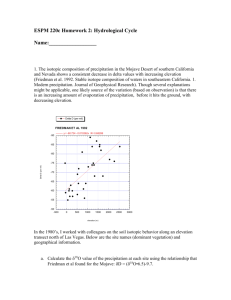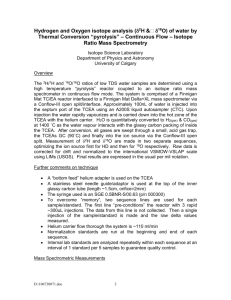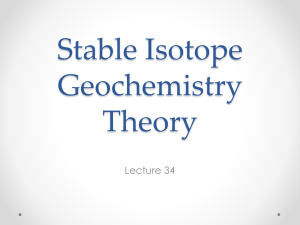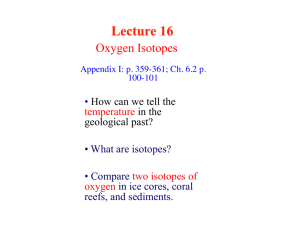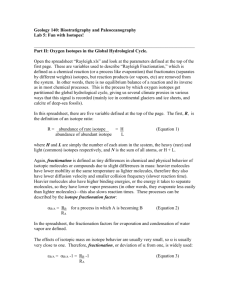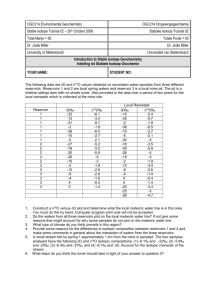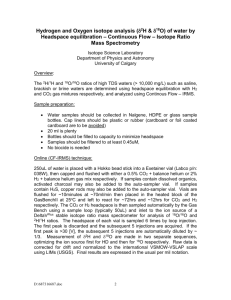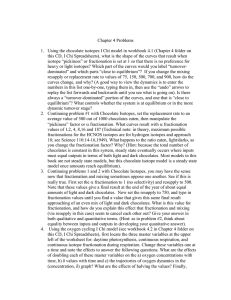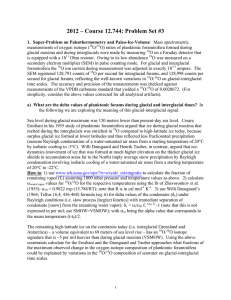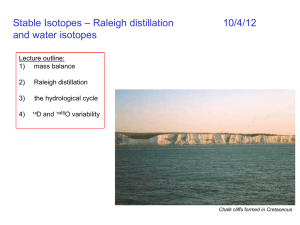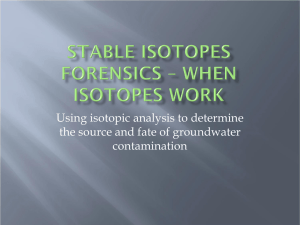Stable isotope geochemistry. To be due 5-28-07.
advertisement
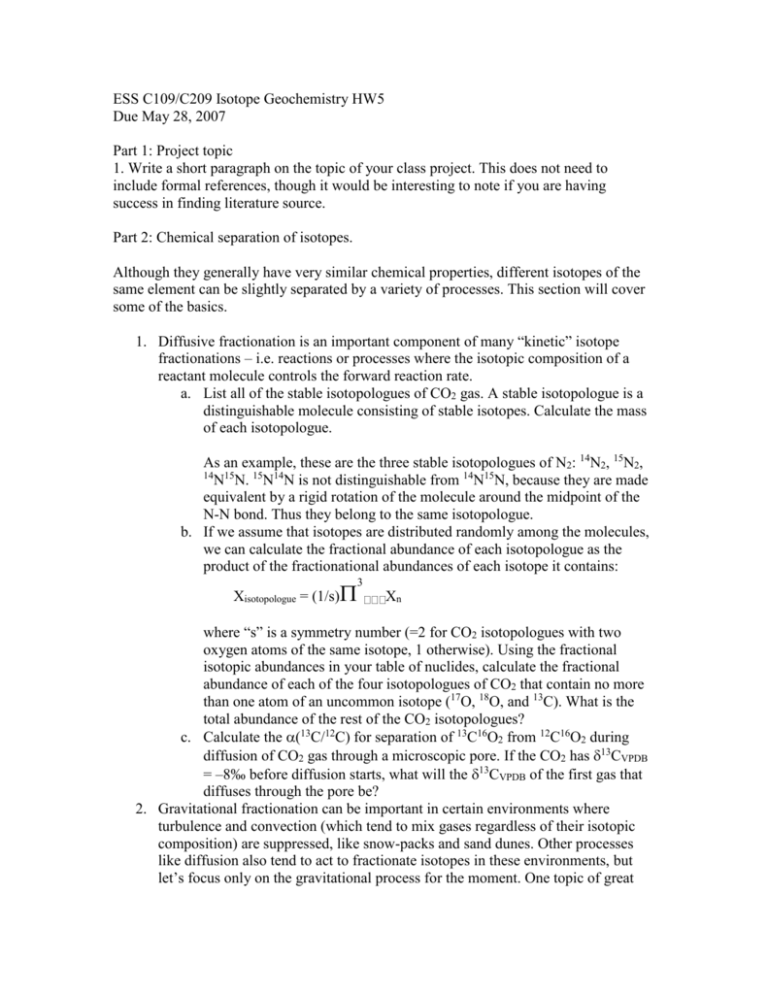
ESS C109/C209 Isotope Geochemistry HW5 Due May 28, 2007 Part 1: Project topic 1. Write a short paragraph on the topic of your class project. This does not need to include formal references, though it would be interesting to note if you are having success in finding literature source. Part 2: Chemical separation of isotopes. Although they generally have very similar chemical properties, different isotopes of the same element can be slightly separated by a variety of processes. This section will cover some of the basics. 1. Diffusive fractionation is an important component of many “kinetic” isotope fractionations – i.e. reactions or processes where the isotopic composition of a reactant molecule controls the forward reaction rate. a. List all of the stable isotopologues of CO2 gas. A stable isotopologue is a distinguishable molecule consisting of stable isotopes. Calculate the mass of each isotopologue. As an example, these are the three stable isotopologues of N2: 14N2, 15N2, 14 15 N N. 15N14N is not distinguishable from 14N15N, because they are made equivalent by a rigid rotation of the molecule around the midpoint of the N-N bond. Thus they belong to the same isotopologue. b. If we assume that isotopes are distributed randomly among the molecules, we can calculate the fractional abundance of each isotopologue as the product of the fractionational abundances of each isotope it contains: Xisotopologue = (1/s) Xn where “s” is a symmetry number (=2 for CO2 isotopologues with two oxygen atoms of the same isotope, 1 otherwise). Using the fractional isotopic abundances in your table of nuclides, calculate the fractional abundance of each of the four isotopologues of CO2 that contain no more than one atom of an uncommon isotope (17O, 18O, and 13C). What is the total abundance of the rest of the CO2 isotopologues? c. Calculate the (13C/12C) for separation of 13C16O2 from 12C16O2 during diffusion of CO2 gas through a microscopic pore. If the CO2 has 13CVPDB = –8‰ before diffusion starts, what will the 13CVPDB of the first gas that diffuses through the pore be? 2. Gravitational fractionation can be important in certain environments where turbulence and convection (which tend to mix gases regardless of their isotopic composition) are suppressed, like snow-packs and sand dunes. Other processes like diffusion also tend to act to fractionate isotopes in these environments, but let’s focus only on the gravitational process for the moment. One topic of great interest to geochemists is reconstructing the carbon-isotope composition of CO2 in the Earths atmosphere during ancient climate changes. a. Calculate the (13C/12C) for CO2 gas at the bottom of a 50m – thick snowpack. What will the 13CVPDB of gas at the bottom of the pile be, if it is –8‰ at the surface? How does this compare with the fractionation of 15 14 N N vs. 14N2? Nitrogen has a very long residence time in the atmosphere, and its isotopic composition changes slowly on geological timescales. b. If gas bubbles are trapped 50m below the surface of a particular location on the Antarctic ice sheet today, how would you expect the trapping depth to change during a cold climate period? How would this affect attempts to use 13C of trapped CO2 to estimate the atmospheric CO2 isotopic composition at the time the gas was trapped? c. What might you measure in ancient trapped gas bubbles to reconstruct the trapping depth? 3. Equilibrium chemical isotope separation is the basis for many types of paleothermometry, particularly the carbonate paleothermometer. Let’s examine equilibrium fractionation in more detail: a. Using the data and equations from the notes on equilibrium isotope fractionation, calculate ClO-Cl for the following reaction for temperatures from 0ºC to 200ºC: 37 Cl + 35ClO 35Cl + 37ClO b. Calculate HCl-Cl over the same temperature range for: 37 Cl + H35Cl 35Cl + H37Cl H35Cl vibrates at 2990.92 cm–1, H37Cl at 2988.65 cm–1. 1 cm–1 = 2.998x1010 Hz. c. Based on the definition of , what is the relationship between ClO-Cl, HCl-Cl, and ClO-HCl? d. Calculate ClO-HCl from 0ºC to 200ºC. Make a plot of ClO-HCl vs. T. What role does oxidation state play in determining which molecule has the highest 37Cl/35Cl? Part 3: Oxygen and hydrogen isotope hydrology: 1. The V-SMOW standard for oxygen and hydrogen isotopes is typically used as the reference for measurements of water and other materials. There is some uncertainty regarding the absolute D/H, 18O/16O, and 17O/16O ratios of V-SMOW, but a widely accepted set of values is: 17 16 O/ O = 0.0003799 18O/16O = 0.0020052 D/H = 0.0001558 a. Calculate the 18O/16O of a Greenland ice sample with 18OVSMOW = –22‰. b. An aliquot of seawater (DVSMOW = 0‰) is allowed to equilibrate with the headspace of a small, closed vessel at 20ºC. The amount of water vapor produced is tiny relative to the remaining liquid. Calculate the D’s of the water vapor and the remaining liquid. c. A droplet of the same seawater is placed in a much larger vessel, and allowed to evaporate at the same temperature. This time 2/3 of the water ends up in the vapor, in equilibrium with the residual water. What are the D’s of the vapor and liquid? Is this an example of a batch process or Rayleigh distillation? d. You set out to measure the 18O of a sample of Sierra Nevada lake water by allowing it to equilibrate with a small amount of CO2 gas (too little to affect the mass balance of 18O in the mixture). After equilibration, the measured 18O of the CO2 is +27.3‰. If CO2-H2O(l)(18O/16O) = 1.0412, what is the 18O of the lake water? 2. In the global weather cycle, water vapor is mainly formed at the surface of the ocean in warm areas near the equator, and then advected elsewhere, forming precipitation whenever the air cools to the point that the saturation vapor pressure of water vapor falls below the actual partial pressure of water in the air (the temperature where this happens is called the dew point). In reality a certain amount of supersaturation is necessary to spur formation of droplets, but we’ll ignore that for present purposes. a. Imagine that wind blowing across a patch of ocean at 25ºC loads up on water vapor until it is saturated. The wind then encounters the mountainous coastline of Maui, where it is forced upwards, expanding and cooling as it rises to the summit of Haleakala at 3.1 km elevation. The saturated lapse rate (dT/dh) = –4.5ºC/km. Assuming that l-v is constant at 1.0098, plot the 18O of the residual vapor and precipitation as a function of elevation up the slope of Haleakala from sea level to the summit. The table below will help you construct the plot: H2O Saturation Pressure T(°C) (kPa) 0 0.61 1 0.66 2 0.71 3 0.76 4 0.81 5 0.87 6 0.93 7 1.00 8 1.07 9 1.15 10 1.23 11 1.31 12 1.40 13 14 15 16 17 18 19 20 21 22 23 24 25 26 27 28 29 30 1.50 1.60 1.70 1.82 1.94 2.06 2.20 2.34 2.49 2.64 2.81 2.98 3.17 3.36 3.56 3.78 4.00 4.24
